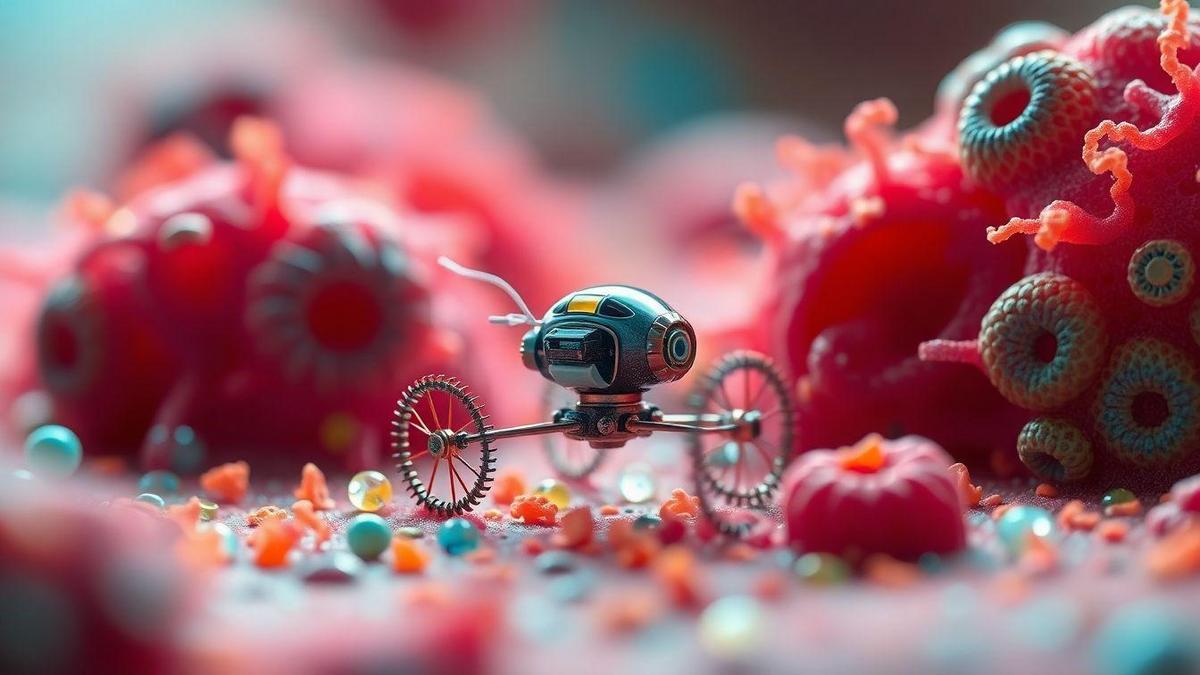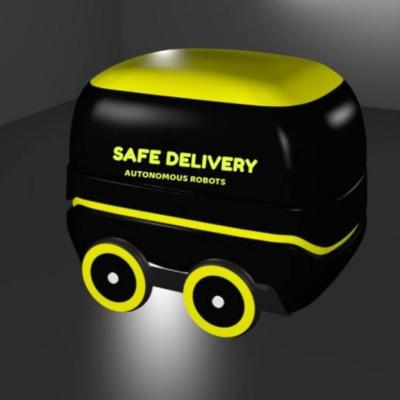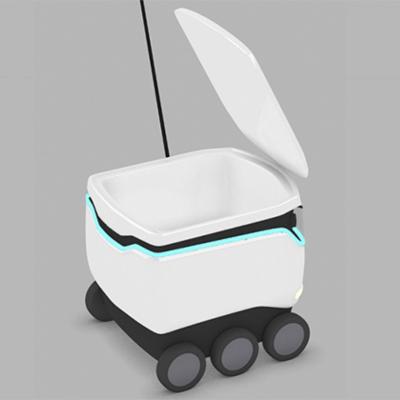Anúncios
These tiny devices can navigate through the body with precision, directly targeting diseased cells. As a result, treatments become more effective with fewer side effects.
This innovation combines biotechnology and cutting-edge engineering to treat complex diseases. When programmed to respond to specific stimuli, they act with extreme precision. The result is a new era for personalized and targeted medicine.
Anúncios

Unprecedented Therapeutic Precision
Microscopic robots can accurately locate the site of disease in the body. Using biological sensors, they identify markers associated with diseased cells. This allows the drug to be released only where it’s needed.
This precision is especially useful in cancer treatments. Cancer often requires aggressive therapies that affect healthy cells. The robots avoid this problem by delivering the drug only to the tumor.
Moreover, the robots reduce the required dosage. Since they deliver the drug directly to the target, less substance is wasted. This minimizes adverse effects and increases treatment efficiency.
Medicine benefits from this new personalized approach. Patients receive customized therapies based on their biological profiles. This is a step forward compared to today’s generalized treatments.
Technologies That Power Microscopic Robots
Microscopic robots move using various innovative methods. Some use helix-shaped structures similar to flagella, inspired by microorganisms. Others are guided by external magnetic fields, precisely controlled.
Propulsion is key to successful drug delivery. It allows the robot to overcome obstacles inside the human body. As a result, it reaches deep tissues and hard-to-access areas.
Some models also use chemical impulses to move. These mechanisms simulate natural reactions to generate force and direction. This makes them even more compatible with the biological environment.
The choice of propulsion method depends on the clinical application. For narrow environments like capillaries, certain technologies work better. The goal is to ensure efficient mobility and safe control.
Drug Release Mechanisms

The drug is released in a controlled and intelligent way. Robots can release the drug upon detecting specific conditions. This includes altered pH, temperature, or the presence of biomarkers.
There are different strategies for storing the drug inside the robot. Some have capsules that dissolve under certain stimuli. Others use coatings that open via chemical reaction or light.
This control prevents the drug from spreading throughout the body. Only the target cells receive the substance, optimizing the treatment. This protects healthy tissues and reduces complications.
Furthermore, some robots can release multiple drugs. This enables combined treatments in a single operation. That’s vital in fighting complex diseases like cancer.
How Microscopic Robots for Targeted Drug Delivery Work
Microscopic robots, also known as microbots or nanobots, are devices designed to perform specific tasks at a microscopic scale. In the context of targeted drug delivery, these robots navigate through the human body—especially the bloodstream—to deliver therapeutic agents precisely where they are needed. This innovative approach is revolutionizing medicine, enabling more effective and efficient treatment of diseases, particularly those hard to reach with conventional therapies. Using advanced materials and sophisticated control mechanisms, these microscopic robots can be programmed to respond to various stimuli, allowing them to carry out their missions with remarkable precision.
The operation of these microscopic robots involves a combination of mechanical engineering, materials science, and biomedical engineering. They are equipped with sensors and actuators that detect environmental signals such as specific biomarkers associated with diseases. After identifying their target, they can release their drug payload directly into affected cells, minimizing the impact on healthy tissues. This targeted approach not only increases treatment effectiveness but also reduces the risk of side effects commonly associated with traditional drug delivery methods. As research in this field progresses, the potential applications of microscopic robots in medicine are expanding, paving the way for more personalized and effective healthcare solutions.
Advantages of Microscopic Robots for Targeted Drug Delivery

One of the main advantages of microscopic robots for targeted drug delivery is their ability to minimize side effects. Traditional drug delivery methods often distribute drugs throughout the body, affecting both healthy and diseased cells. In contrast, microscopic robots can be designed to target only affected areas, significantly reducing the likelihood of adverse reactions. This targeted approach allows for higher doses of drugs to be delivered directly to the site of action, leading to better therapeutic outcomes.
Another major advantage is the precision with which these robots can operate. Microscopic robots can be programmed to respond to specific biological markers or environmental conditions, allowing them to navigate to the exact location where their therapeutic payload is needed. This level of precision is particularly beneficial in treating complex diseases like cancer, where tumor cells can be difficult to distinguish from healthy cells. By delivering drugs directly to the tumor site, these robots can increase treatment effectiveness while sparing healthy tissues from unnecessary exposure to toxic medications.
Additionally, microscopic robots can be designed to carry multiple types of drugs simultaneously, enabling combination therapies that can target different pathways involved in disease progression. This capability is especially important in cancer treatment, where tumors often develop resistance to single-agent therapies. By using microscopic robots to deliver a drug combination, healthcare professionals can more effectively combat tumor growth and improve patient outcomes.
Finally, the development of microscopic robots for targeted drug delivery represents a significant advancement in personalized medicine. Since these robots can be tailored to deliver specific therapies based on individual patient profiles, they have the potential to revolutionize treatment protocols. This personalized approach not only improves treatment efficacy but also allows for better management of chronic diseases, leading to enhanced quality of life for patients.
How Microscopic Robots for Targeted Drug Delivery Operate
Microscopic robots are designed to operate within the human body, using advanced technologies to navigate and deliver drugs effectively. These robots can move through the bloodstream using various propulsion mechanisms, such as flagella-like structures or magnetic fields, to travel toward their target. Their ability to maneuver through the circulatory system allows them to reach areas that would otherwise be difficult to access, enhancing their therapeutic potential.
Once microscopic robots are near the target site, they can deliver drugs directly to the affected area. This targeted delivery is achieved through the use of specialized coatings or surface modifications that allow the robots to adhere to specific cell types. By attaching to the target cells, these robots can release their therapeutic payload in a controlled manner, ensuring that drugs are administered precisely where they are needed.
In addition to their drug delivery capabilities, microscopic robots can also be equipped with diagnostic tools that monitor treatment status in real time. By collecting data about the local environment and the response of target cells, these robots can provide valuable insights into therapy effectiveness, allowing healthcare providers to make informed decisions about treatment adjustments.
- Microscopic robots can navigate through the bloodstream using propulsion mechanisms to reach target locations.
- They deliver drugs directly to the affected area, increasing treatment precision.
- These robots can be programmed for specific tasks, enabling personalized therapies.
- They minimize side effects by targeting only diseased cells, sparing healthy tissues.
- Microscopic robots can enhance therapy effectiveness through combined drug delivery.
- They are part of advanced biomedical engineering solutions, paving the way for personalized medicine.
In conclusion, the operation of microscopic robots for targeted drug delivery represents a significant advancement in medical technology. Their ability to navigate the bloodstream, deliver drugs directly to affected areas, and provide real-time diagnostics makes them a powerful tool in the fight against disease. As research in this field continues to evolve, the potential of these robots to transform healthcare is immense, offering hope for more effective and personalized treatment options.
Did You Enjoy Learning About Microscopic Robots for Targeted Drug Delivery?
Learning about microscopic robots for targeted drug delivery opens up a fascinating world of possibilities in modern medicine. These innovative devices are not just science fiction—they’re becoming a reality, promising to change how we approach disease treatment. The potential of these robots to deliver targeted therapies could lead to advances in managing chronic conditions and improving patient outcomes.
As the field of biomedical engineering advances, the integration of microscopic robots into clinical practice is on the horizon. The more we understand their capabilities and functions, the closer we get to realizing a future where diseases can be treated with unprecedented precision and effectiveness. The journey into the world of microscopic robots is just beginning, and it’s an exciting time for both researchers and patients.
Frequently Asked Questions
What are microscopic robots for targeted drug delivery?
Microscopic robots for targeted drug delivery are tiny devices that transport medications directly to diseased cells. This helps focus the treatment and reduces side effects.
How do microscopic robots find target cells?
They use sensors and chemical signals. These robots can detect where the drug is most needed, moving to the correct location.
What diseases can microscopic robots treat?
These robots show promise for various diseases, potentially aiding in the treatment of cancer, autoimmune diseases, and infections.
Are microscopic robots safe?
Yes, they are designed to be safe. Scientists conduct extensive testing before they are used in humans. Safety is always the top priority!
Where can I learn more about microscopic robots for targeted drug delivery?
You can find information on science and medical websites. Universities and research articles also provide details. It’s a rapidly growing field!
